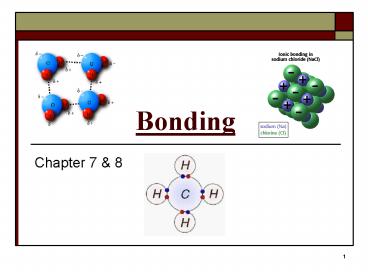Bonding - PowerPoint PPT Presentation
1 / 20
Title:
Bonding
Description:
Exothermic where Heat or E is a product and is released from the system ... Weak force-but helps geckos defy gravity. Seen in noble gases and diatomics ... – PowerPoint PPT presentation
Number of Views:93
Avg rating:3.0/5.0
Title: Bonding
1
Bonding
- Chapter 7 8
2
Endothermic vs. Exothermic
- Energy is required to break a bond
- Endothermic where Heat or E is a reactant and
absorbed into system - Energy is released when a bond is formed
- Exothermic where Heat or E is a product and is
released from the system - When a bond forms, the new compound has less
potential energy than the reactants (E released) - The more E released, the more stable the compound
3
Ionic vs. Covalent
- Ionic Bonding atoms will gain/lose e- to other
atoms - /- ions form and attract to one another
- Covalent Bonding atoms share e- pairs equally
- A bond is never purely Ionic or Covalent, but is
a combination depending on electronegativity
differences (Table S) - If difference between atoms is roughly
- 0.0 Non polar covalent (0.0-0.3)
- 0.1-1.7 Polar covalent (0.3-1.7)
- 1.7-3.3 Ionic
4
Ionic vs. Covalent continued
- Ionic Bonding occurs between a metal and
non-metal - Electronegativity differences 1.7 or greater
- Ex. NaCl, LiBr
- Covalent Bonding occurs between two, or more,
non-metals - Electronegativity differences 1.7 or less
- Ex. CO2, CH4
5
Ionic Compounds
- Most exist as crystalline solid (lattice
structure) - Chemical formula shows the ratio of ions present
that give electrical neutrality (NaCl) - Formation of 3D arrangement will decrease the
potential energy of the structure (becomes more
stable) - () ion cation (-) ion anion
6
Characteristics of Ionic Bonds
- Solid
- Crystal structure
- Very strong bonds
- High melting and boiling points
- Hard and brittle
- Non conductors of electricity
- Liquid (typically molten)
- Broken bonds allow for mobility of ions
- Better conductor of electricity (than solid)
- Solution (dissolved in water)
- Crystal completely destroyed
- Ions become mobile and are good conductors of
electricity
7
Characteristics of Covalent Bonds
- Molecular structure
- Weaker bonds (smaller differences in
electronegativity compared to ionic bonds) - Low melting points
- Non conductors of electricity
- Soft as solids
8
Electron Sharing
- Single Covalent Bond sharing of 1 pair or 2e-
- Double Covalent Bond sharing of 2 pair or 4e-
- Triple Covalent Bond sharing of 3 pair or 6e-
H C C H
9
Non-Polar vs. Polar Molecules
- Non-polar covalent equal sharing of e- and
balanced electrical charge - Polar covalent e- is attracted more towards the
greater electronegative atom, therefore creating
an unequal distribution of charge. Ex. Water is
a polar molecule
10
Polar molecules continued
- Delta (d) is used to represent partial charges
- d- such as in Oxygen of a water molecule
- O pulls e- more so it is a partially (-) end
- d such as in Hydrogen of a water molecule
- H has e- pulled away so it is a partially () end
11
Molecular Geometry Based on VSEPR
- Valence Shell Electron Pair Repulsion
- Shape of molecule depends on the of bonds and
non-bonding electron pairs (lone pairs) - Shape will help determine polarity of molecule
- Ex. Water is a polar molecule because of its bent
shape (asymmetrical) - Oxygen is non-polar because of its linear and
symmetrical shape
12
Molecular Geometry continued
- Molecules with symmetry are usually non-polar
- Molecules without symmetry are usually polar
13
Coordinate Covalent Bonds
- One atom provides both electrons that are shared
in a bond - Ex. Hydronium ion H3O (found in water and acids)
- H 1 valence electron
- H 0 valence electrons (same as Proton)
- H will attract to d- end of H2O
- () ion results
- This is also the case with the ammonium ion (NH4)
14
Network solids
- Covalent bonding with millions of atoms in a
crystalline network - Macromolecules (large)
- Very strong bonds
- High melting points
- Non-conductors of electricity
- Ex. diamond/graphite/asbestos/silicon dioxide
15
Metallic Bonding
- Bonding between metal atoms in a pure substance
- Consists of an arrangement of positive ions in a
sea of mobile electrons (A in diagram below) - Mobile electrons give the metals
- Strength
- Malleability (D)
- Ability to conduct electricity/heat (B/C)
16
Intermolecular Forces Between Molecules
- Are not true bonds and can be separated
relatively easy - Dipole Attraction
- Exists between polar molecules
- Opposite partial charges attract
- Are weak forces
17
Intermolecular Forces continued
- Hydrogen Bonding
- Between polar molecules containing Hydrogen with
O, N and F - Hydrogen bonds are strongest with H d and an
atom with a small atomic radius and high
electrogenativity
18
Intermolecular Forces continued
- Vander waals Forces
- Between nonpolar molecules due to a momentary
imbalance in electron sharing - Weak force-but helps geckos defy gravity
- Seen in noble gases and diatomics
- H2, O2, F2, Br2, I2, N2, Cl2,
- Force increases as
- Distance between molecules decreases
- Size of molecule increases
- Ex. Iodine (I2) ?
- Which will be strongest? Br2(l), I2(s), Cl2(g)
- ? I2, as it has the largest radius and thus
closer molecules due to being a solid
19
Ion-Molecule Attractions
- Ex. When dissolving substances in water
- d side of the molecule will attack () ion
- d- side of the molecule will attack () ion
20
Resonance
- More than one Lewis structure may represent a
molecule (average between the two is considered
as either could exist) - Designated by a double arrow
- Ex. Benzene (C6H6) and Ozone (O3)
1
1
2
2
6
6
5
3
3
5
4
4































